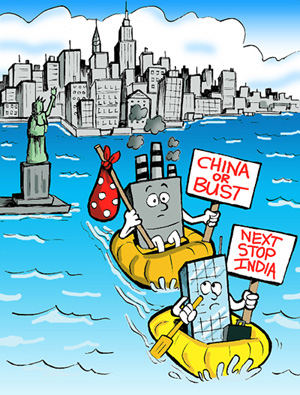 As global business leaders hob-nob on the Swiss ski lopes during the World Economic Forum held this week in Davos, the world’s business axis is slowly twisting south-west. To be more precise from China to India.
As global business leaders hob-nob on the Swiss ski lopes during the World Economic Forum held this week in Davos, the world’s business axis is slowly twisting south-west. To be more precise from China to India.
While India might not have the largest contingent and their best cards might be the ‘Incredible India’ and its spin off ‘Inclusive India’, power is moving to the south Asian nation. Realizing a talented workforce, Chinese companies are coming to India to hire financial wizards and number crunching analysts, higher operational and over head costs in the Mainland, compounded worse by the appreciating yuan , also mean that manufacturing and supply chains are moving across the Himalayan gap into India.
As recruitment season nears, Chinese companies are jostling for India’s best talent at the country’s top B-schools. For the first time, Chinese financial companies will visit IIM Calcutta (IIM-C) for campus recruitment, reported the Times of India. And why not? Devoid of skills and resources post the cultural revolution, the Chinese have been traditionally known to adopt global best practices. As a result of which they have the best in manufacturing from Germany, the best in marketing from America, the best in software from India, the best legal system from around the world and now the best financial would-be guru’s from India.
 However after having recruited the best, and having driven the global economy on rock bottom prices, inflation and the quest for a better standard of living are raising salaries and costs across the Mainland, as a result of which many basic, low-end manufacturing jobs are moving to India and Vietnam. Some 57 per cent of buyers of China products, who expect to increase sourcing in other countries, are planning to boost imports from India, a survey by Global Sources found.
However after having recruited the best, and having driven the global economy on rock bottom prices, inflation and the quest for a better standard of living are raising salaries and costs across the Mainland, as a result of which many basic, low-end manufacturing jobs are moving to India and Vietnam. Some 57 per cent of buyers of China products, who expect to increase sourcing in other countries, are planning to boost imports from India, a survey by Global Sources found.
The change is the result of increased export prices in China, which has been driven by escalating costs and a stronger yuan. More than two-thirds of buyers said the yuan’s appreciation had swayed their sourcing decisions.
The survey, conducted last month, was mainly of EU and US buyers and covered industries including electronics, home products, clothing and hardware.
With manufacturing moving to India, China now enters its second phase of growth, that which is more concentrated on environment friendly business practices and the manufacturing of higher end and more value-added products. It will also mean that India and China will share greater synergies and parted and components could be manufactured in India and sophisticated in China. It will also mean that supply chains which ten years ago could never dream of excluding China, will now turn a keener eye towards India. Nestled strategically between the Middle East and Far East, India is expected to emerge as a global sourcing hub, infrastructure for which is already being built.
